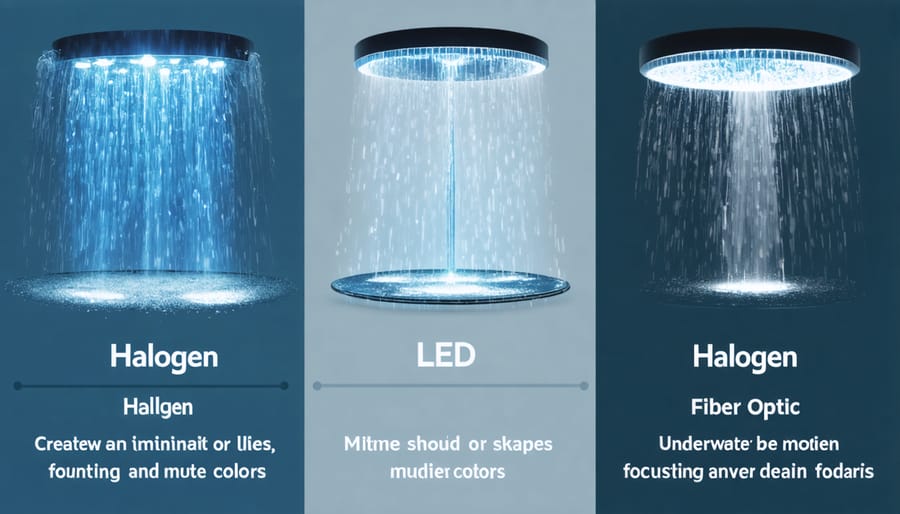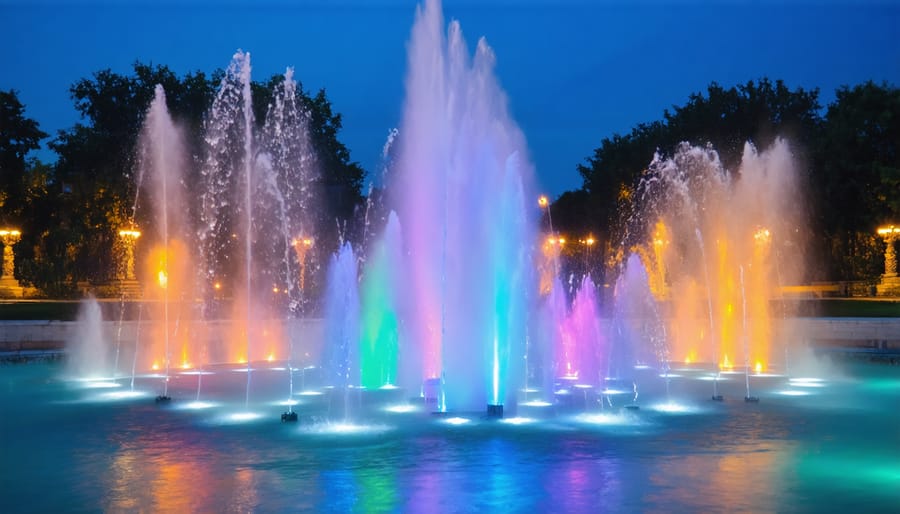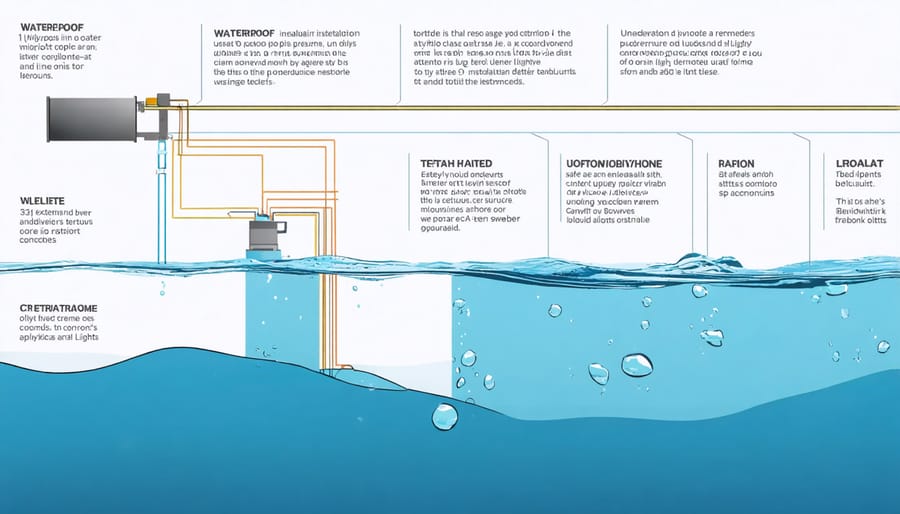
Transform Your Fountain Into a Mesmerizing Light Show at Night
Transform your fountain into a magical nighttime display with strategically placed underwater LED lights that create stunning reflections and dramatic water effects. Position spotlights at 45-degree angles beneath water jets to maximize light dispersion and minimize glare, while using warm white lights (2700K-3000K) to achieve a natural, inviting ambiance. Install waterproof LED strips along fountain walls or beneath cascading features to create seamless illumination that highlights water movement and architectural details.
Select submersible fixtures rated IP68 or higher to ensure long-term reliability and safety in underwater conditions. Modern LED systems offer color-changing capabilities and smart controls, allowing you to adjust brightness levels and create dynamic lighting scenes that respond to different occasions or seasons. When planning your lighting layout, consider incorporating multiple layers of light – uplighting for vertical elements, accent lighting for water features, and peripheral illumination for surrounding landscaping – to create depth and visual interest that transforms your fountain into a captivating focal point after dark.
Essential Lighting Basics for Water Features
Types of Underwater Lights
When it comes to outdoor lighting options for fountains, three main types stand out: LED, halogen, and fiber optic lights. LED lights are the most popular choice today, offering incredible energy efficiency and longevity. They run cool, require minimal maintenance, and come in various colors that you can often control remotely.
Halogen lights, while older technology, still have their place in fountain lighting. They produce a warm, natural light that many find appealing, though they use more energy and need more frequent replacement than LEDs. Keep in mind that halogen bulbs generate more heat, which means they need careful placement to avoid affecting water temperature.
Fiber optic lighting offers a unique solution, with the light source located away from the water. Light travels through flexible cables, making it incredibly safe and versatile for fountain designs. While typically more expensive initially, fiber optics provide excellent durability and creative lighting possibilities, perfect for creating subtle, starlight effects in your water feature.

Light Placement Strategies
Strategic light placement can transform your fountain from beautiful to breathtaking. For a dramatic upward effect, position lights at the base of water streams, angling them slightly to follow the water’s movement. This creates magical pillars of illuminated water that dance in the night.
To highlight specific fountain features, place lights about 12 inches away from the element you want to showcase. Remember to angle them at roughly 45 degrees to minimize glare and maximize visibility. For a softer, more natural look, try positioning lights behind decorative elements or rocks, creating subtle shadows and depth.
For moving water features, consider placing lights both above and below the water line. Above-water lights create sparkling effects on the surface, while submerged lights illuminate the entire water column. In circular fountains, space three to four lights evenly around the perimeter for balanced illumination.
For the most enchanting results, layer your lighting by combining different positions and angles. Start with base lighting for overall illumination, then add accent lights to highlight specific features. This creates depth and visual interest that truly brings your fountain to life after dark.
Creating Dynamic Light Effects
Color-Changing Systems
Modern color-changing systems have revolutionized underwater lighting techniques, making it easier than ever to create stunning fountain displays. The heart of these systems is typically an RGB LED controller, which lets you mix red, green, and blue light to produce virtually any color you desire.
To set up a color-changing system, start with a compatible LED light fixture and controller. Many modern units come with user-friendly remote controls or smartphone apps that make programming a breeze. You can create simple fade effects between colors or program complex sequences for special occasions.
The basic controls usually include:
– Color selection wheel or preset color options
– Speed adjustment for color transitions
– Brightness control
– Pattern selection (steady, fade, flash, etc.)
– Timer functions for automated operation
For the best results, consider using multiple lights positioned strategically around your fountain. This creates depth and ensures even illumination from all angles. Remember to synchronize your lights so they change colors together, creating a cohesive display.
Many systems also offer preset programs for holidays or seasons – think red and green for Christmas or orange for Halloween. You can usually save your favorite combinations for quick access later. For more advanced users, DMX controllers allow precise timing and professional-grade programming capabilities.
When installing your system, make sure all components are properly waterproofed and rated for underwater use. It’s also worth investing in quality connectors and running your cables through protective conduit to ensure long-term reliability.

Synchronizing Lights with Water Movement
Creating a mesmerizing display with your fountain lighting means synchronizing your lights with the water movement for maximum impact. The key is understanding how different water fountain designs interact with light to create stunning effects.
Start by observing your fountain’s natural flow patterns. Does it create a gentle cascade, multiple jets, or a dramatic vertical spray? Match your lighting rhythm to these movements. For cascading fountains, try programming your lights to fade up gradually as the water falls, creating a shimmer effect that mimics natural waterfalls.
Color-changing LED lights work particularly well when timed with water patterns. For instance, set blue lights to intensify when water jets reach their peak, then transition to softer whites as the water descends. Many modern LED controllers allow you to create custom sequences that complement your fountain’s specific movement patterns.
Consider these practical tips:
– Use shorter intervals for dynamic water features
– Sync light changes with the fountain’s natural rhythm
– Create contrast between water movements and light transitions
– Program slower transitions for peaceful ambiance
– Match lighting intensity to water volume
Remember to test your lighting sequences during both day and night. What looks subtle during daylight might appear too intense after dark. Start with simple patterns and gradually experiment with more complex sequences as you become comfortable with your lighting system’s capabilities.
For the best results, adjust your timing seasonally. Wind conditions and temperature changes can affect water patterns, so be prepared to fine-tune your lighting synchronization accordingly.
Installation and Safety Considerations

Waterproofing and Power Requirements
When it comes to underwater lighting, safety should always be your top priority. All fountain lights must have proper waterproof ratings – look for fixtures rated IP68, which means they’re completely protected against water immersion. Don’t settle for anything less, as lower ratings might lead to dangerous electrical issues down the line.
For power requirements, most underwater fountain lights operate on 12V or 24V low-voltage systems, making them much safer than standard 120V household current. You’ll need a transformer to convert your home’s AC power to the appropriate low voltage DC power for your lights. Make sure to choose a transformer that can handle the total wattage of all your lights with about 20% extra capacity for safety.
All electrical connections must be properly sealed with waterproof connectors. Regular electrical tape won’t cut it – invest in high-quality waterproof junction boxes and marine-grade cable glands. Place your transformer in a weather-proof enclosure above the water level, ideally at least 12 inches above the highest water mark.
Remember to check local electrical codes before installation. Many areas require GFCI (Ground Fault Circuit Interrupter) protection for underwater lighting. It’s also wise to have a qualified electrician review your setup, especially if you’re new to working with outdoor electrical systems.
Maintenance Tips
Regular maintenance of your underwater fountain lights ensures they continue to shine brightly and operate safely. Start by cleaning the light fixtures every three months using a soft brush and mild soap to remove algae buildup and mineral deposits. Be sure to check the fixtures while they’re running to spot any flickering or dimming, which could indicate electrical issues.
Always inspect the cable connections and seals during your routine maintenance. Look for signs of wear, cracks, or water intrusion. If you notice any damage, replace the affected parts immediately to prevent electrical hazards. It’s also important to trim any nearby plants that might grow over the lights, as they can block the illumination and potentially damage the fixtures.
For LED lights, check that all bulbs are functioning properly. While LEDs typically last for years, individual bulbs can occasionally fail. If you have halogen lights, plan to replace the bulbs annually, even if they’re still working, as their brightness diminishes over time.
During winter months in colder climates, consider removing the lights if you’re draining the fountain. If keeping them installed, ensure they’re rated for winter use and check them more frequently for ice damage. Keep a maintenance log to track when you perform checks and replacements – this helps establish a routine and anticipate when components might need attention.
Remember to always disconnect the power before performing any maintenance work, and if you’re unsure about any electrical issues, consult a professional electrician.
Smart Control Options
Remote Control Systems
Modern fountain lighting has embraced smart technology, making it easier than ever to control your underwater lights from the comfort of your smartphone. Most current LED fountain lights come with wireless remote controls that let you adjust brightness, change colors, and set timing schedules with just a few taps.
Popular remote control options include Bluetooth-enabled systems that work within a 30-50 foot range, perfect for most home installations. These systems typically come with user-friendly apps that transform your phone into a powerful control center. You can create custom light shows, synchronize multiple lights, and even set your lights to automatically turn on at sunset.
WiFi-enabled systems take it a step further, allowing you to control your fountain lights from anywhere with an internet connection. Some advanced systems even integrate with smart home platforms like Alexa or Google Home, letting you control your fountain lights with voice commands.
For those concerned about reliability, most remote systems include backup manual controls and memory functions that remember your settings even if the power goes out. Many also feature automatic scheduling to help save energy while keeping your fountain beautifully lit when needed.
Automated Programming
Modern fountain lighting controllers make it easy to create stunning displays that change automatically throughout the day and year. Setting up automated programs starts with choosing your desired lighting scenes – from subtle color transitions to dynamic light shows. Most controllers let you schedule different effects for specific times, like soft blue lighting during evening dinners or festive colors during holidays.
To program your lighting schedule, connect your controller to its companion app or use the built-in interface. Start by setting your location’s sunrise and sunset times, which allows the lights to adjust automatically with seasonal changes. Create different scenes for various occasions, like gentle white lighting for everyday use and colorful displays for special events.
Many controllers offer preset seasonal themes you can enable with a single click. For example, orange and purple for Halloween, red and green for Christmas, or pastels for spring. Some advanced systems even synchronize with music or respond to water movement, creating an immersive experience that brings your fountain to life.
Remember to periodically review and adjust your programmed settings to ensure they align with your current preferences and seasonal changes. This keeps your fountain display fresh and engaging throughout the year.
Transforming your fountain with underwater lighting can truly bring magic to your outdoor space. As we’ve explored, the right combination of lighting types, placement, and effects can create stunning displays that enhance your water feature day and night. Remember that successful underwater lighting isn’t just about aesthetics – it’s about finding the perfect balance between visual impact, safety, and practical maintenance.
Don’t be afraid to experiment with different lighting combinations and positions to discover what works best for your fountain. Start with a basic setup and gradually add elements as you become more comfortable with the technology. You might be surprised by how changing the angle of a single light or adding a color-changing LED can completely transform the atmosphere of your outdoor space.
Whether you’re aiming for subtle illumination or a dramatic display, the key is to plan carefully, prioritize safety, and maintain your lighting system regularly. With the knowledge you’ve gained from this guide, you’re well-equipped to create a beautiful, well-lit fountain that will become the centerpiece of your garden or patio. So go ahead – dive into the world of underwater fountain lighting and watch your outdoor space come alive after dark!
